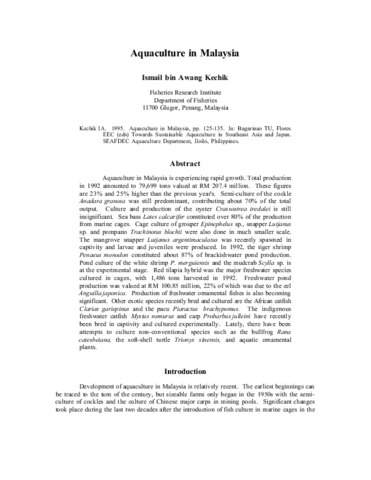Screening of inexpensive and indigeneous ingredients for use in practical feed for juvile sea bass (Lates calcarifer Bloch)
- Global styles
- MLA
- Vancouver
- Elsevier - Harvard
- APA
- Help

Date
1996Page views
7,679ASFA keyword
AGROVOC keyword
Taxonomic term
Metadata
Show full item record
Share
Abstract
An eight-week feeding experiment with juvenile sea bass (about 15 g) was conducted in 500-1 fiberglass tanks to screen the most cost-effective practical diet for use in ponds and floating cages. Eleven formulations and one control feed were tested. Protein sources used were locally available ingredients such as fish meal, shrimp head meal, scrap squid meal, cow's blood meal, poultry feather meal, leaf meals, soybean meal, and mung bean meal. The diets contained a combination of animal and vegetable protein sources such that the essential amino acid composition was close to the requirement or tissue levels. Crude protein and fat levels were about 42% and 8.3%, respectively. Fish were fed ad libitum twice a day at 0800 and 1600 h. Best weight gain (189%) and feed conversion ratio (FCR, 1.7) were observed in fish given a combination of fish meal, shrimp head meal, scrap squid meal, soybean bean meal, and kangkong leaf meal as protein sources. This was followed by those given a combination of fish meal, shrimp head meal, scrap squid meal, soybean meal, and ipil-ipil leaf meal (139% weight gain, FCR of 2.2). Worst growth (22%) and FCR were observed in fish given a combination of fish meal, cow's blood meal, scrap squid meal, soybean meal, and mulberry leaf meal. Control fish given a combination of fish meal, shrimp meal, and soybean meal showed weight gain of 195% and FCR of 1.8. Survival was high (83-100%) in all treatments. The two diets which gave the best growth rates, survival, and FCR in the screening phase can be tried in ponds and floating net cages.
Description
Abstract only
Type
Conference paperCollections
Related items
Showing items related by title, author, creator and subject.
-
Aquaculture in Malaysia
Kechik, Ismail bin Awang. (Aquaculture Department, Southeast Asian Fisheries Development Center, 1995)Aquaculture in Malaysia is experiencing rapid growth. Total production in 1992 amounted to 79,699 tons valued at RM 207.4 million. These figures are 23% and 25% higher than the previous year's. Semi-culture of the cockle ... -
Coastal aquaculture in Thailand
Sahavacharin, Songchai (Aquaculture Department, Southeast Asian Fisheries Development Center, 1995)Coastal aquaculture in Thailand has expanded rapidly in both area and production in the last decade. The important cultured species are the shrimps (Penaeus monodon and P. merguiensis), sea bass Lates calcarifer, groupers ... -
Aquaculture in the Philippines
Aypa, Simeona M. (Aquaculture Department, Southeast Asian Fisheries Development Center, 1995)Aquaculture is regarded as the most promising source of protein food in the years ahead. Milkfish and Nile tilapia are the major fishes now produced but groupers, sea bass, rabbitfish, red snappers, carps, and catfishes ...






